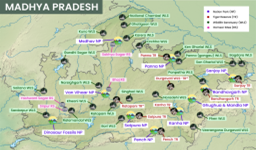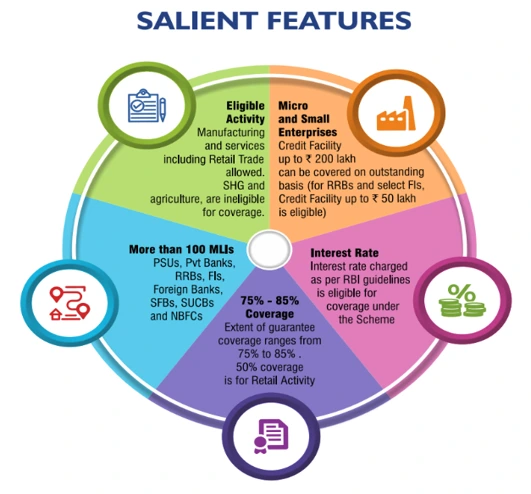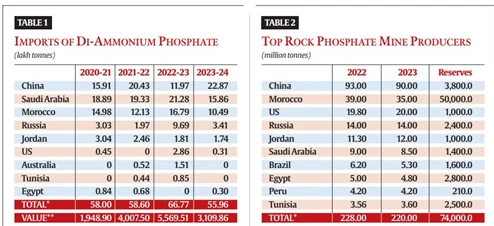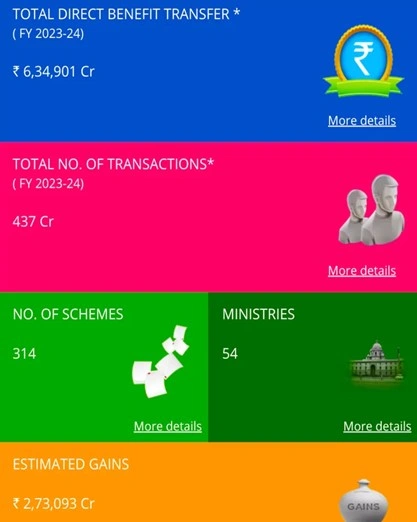Friday, 20th September 2024
Cabinet clears plan for ‘One Nation, One Election’
Why in the news ?
- Recently, recommendations of the High-Level Committee on ONOE/Simultaneous Elections under chairmanship of former President Shri Ram Nath Kovind.
What does ONOE mean?
About: It holding elections for the People’s House, the national assembly and all local bodies, ie. municipalities and panchayats together.
Benefits of ONOE:
- Government exchequer deficit: 2019 LS election cost Rs 60,000 crore.
- Increase the number of voters: e.g. Every day voting brings ‘voter fatigue’.
- Stability of Structure and Growth: Currently, the constant imposition of exemplary codes of conduct leads to structural paralysis affecting the supply chain, business investment and economic growth.
- Effective delivery of services: Officials and security forces, often used in elections, negatively affect their service delivery
Issues With ONOE:
- Marginalisation of the region parties: State parties can Mute the little one’s voice of parties at the national level
- Reduced Responsibility in Politics Leadership: Elections are held daily Keep lawmakers on their toes.
- Concerns Federalism: Due to Multiple charges Article 356.
- Concerns about independent thought Qualifying Votes: There had been a simultaneous election Voters combining national and state issues.
Roadmap recommended by high level committee:
- Constitutional amendment in two ways:- .
- 1st: Simultaneous Lok Sabha and Assembly elections (without the need for state approval).
- 2nd: Coordination of the first phase with local elections by holding municipal and panchayat elections more frequently in 100 days voting (requires ratification by less than half of states).
- Dealing with a hung House/no confidence motion: Fresh elections for constituting a new House of People or State Legislative Assembly for an unexpired term of the House of the People.
|
UPSC Civil Services Examination Previous Year Question (PYQ) Prelims Q1. Consider the following statements: (2020)
Which of the statements given above is/are correct?
Answer: (d)
Q2. Consider the following statements: (2017)
Which of the statements given above is/are correct?
Answer: (d) Mains Q.1 ‘Simultaneous election to the Lok Sabha and the State Assemblies will limit the amount of time and money spent in electioneering but it will reduce the government’s accountability to the people’ Discuss. (2017) |
Source: HT
PM Janjatiya Unnat Gram Abhiyan (PM-JUGA)
Why in the news ?
- The Cabinet approved PM-JUGA with an outlay of ₹79,156 crore to fill critical social infrastructure gaps and build on the success of PM-JANMAN.
About the PM Janjatiya Unnat Gram Abhiyan (PM-JUGA):
- Objective: Improving the socio-economic condition of tribal communities by adopting saturation coverage for tribal families in tribal-majority villages and aspirational districts.
- Coverage: It will cover 63,000 villages in 30 states and is aimed at benefiting five crore tribal people.
- Implementation:
- Comprises 25 interventions to be implemented by 17- line ministries through funds allocated under Development Action Plan for Scheduled Tribes (DAPST) in next 5 years
- The said tribal villages will be mapped and progress will be monitored on the PM Speed power platform.
- It is a unique example of collaboration and the whole government approach.
- Comprises 25 interventions to be implemented by 17- line ministries through funds allocated under Development Action Plan for Scheduled Tribes (DAPST) in next 5 years
- The four objectives of the mission are:
- Objective-I: Development of facilities like Pucca house for Improving household and village infrastructure.
- Objective-2: Promote economic empowerment through skill development Career development and social development (self-employment).
- Objective-3: Access to quality education will be universal
- Objective-4: Healthy living and dignified ageing.
- Innovative Schemes under PM JUGA:
- Tribal Home Stay: 1,000 home stays will be promoted under Swadesh Darshan to boost tourism in tribal areas and offer alternative livelihoods. Financial aid includes ₹5 lakhs for new room construction, ₹3 lakhs for renovation, and ₹5 lakhs for village community needs.
- Sustainable Livelihood for FRA Holders: Expedite forest rights recognition, empower tribal communities to conserve forests, and ensure sustainable livelihoods through various schemes.
- Infrastructure Improvement for Schools/Hostels: Upgrade Ashrams, hostels, tribal schools, and government residential schools to PM-SHRI standards.
- Sickle Cell Disease Diagnosis: Centres of Competence (CoC) to be set up in AIIMS and top institutes in states affected by Sickle Cell Disease.
- Tribal Multipurpose Marketing Centres (TMMCs): 100 TMMCs will be established to ensure fair prices for tribal products and direct consumer access to tribal goods.
Source: PIB
Bio-RIDE scheme
Why in the news ?
- Recently, the Union Cabinet approved one scheme-‘Biotechnology Research Innovation and Entrepreneurship Development (Bio- RIDE)’.
About Bio-RIDE Scheme:
- Aim: To accelerate research, enhance product development, and bridge the gap between academic research and industrial applications.
- Objective
- Strengthen India’s position as a global leader in biomanufacturing and biotechnology.
- Make India a US$300 billion bioeconomy by 2030.
Components of the Bio-RIDE Scheme:
- Biotechnology Research and Development (R&D)
- Focus on:
- Human resource development.
- Bioinformatics and biotech facilities.
- Establishment of Centres of Excellence.
- Focus on:
- Industrial and Entrepreneurship Development (I&ED)
- Focus on:
- Public-Private Partnership (PPP) programmes.
- Development of bio-clusters and biotech parks.
- Focus on:
- Biomanufacturing and Biofoundry
- Aligned with the Lifestyle for the Environment (LiFE) initiative.
- Aim: Promote circular bioeconomy through sustainable biomanufacturing.
- Key areas:
- Indigenous biomanufacturing solutions.
- Healthcare, agriculture productivity, bioeconomy growth.
- Skill development and entrepreneurial momentum.
Funding and Duration:
- Outlay: ₹ 9,197 crore during the 15th Finance Commission period (2021-22 to 2025-26).
Implementation of Scheme:
- Promote Bio-Entrepreneurship
- Grants and incentives for R&D in synthetic biology, biopharmaceuticals, bioenergy, and bioplastics.
- Creating synergies to accelerate commercialization of bio-based products.
- Encourage Sustainable Biomanufacturing
- Nurturing Human Resource in Biotechnology sector
Source: PIB
Pradhan Mantri Annadata Aay SanraksHan Abhiyan
Why in the news ?
- Recently, the Union cabinet extended the PM-AASHA price support scheme in agriculture till 2025-26.
About Pradhan Mantri Annadata Aay SanraksHan Abhiyan (PM-AASHA):
- Objective : To ensure adequate compensation to farmers for their Production of oilseeds, pulses, copra etc.
- Total Expenditure: Rs. 35,000 crore in FY15 Commission cycle through 2025-26.
- Components of Scheme:
- Credit Support Scheme (PSS): Commercial notified buyers, oilseeds & copra are fixed at minimum support prices under PSS 25% of the gross domestic product.
- No roofing around Tur, Urad & Masur For the 2024-25 season.
- Price Stabilization Fund (PSF): Government purchases Pulses at market prices above MSP including pre-registered farmers in eSamridhi (NAFED) and eSanyukti (NCCF) Methodology.
- Depreciation Payment Scheme (PDPS): Sesame seed cover went up to 40%, with a validity of 4 months.
- Market Integration System (MIS): Increased MIS reimbursement up to 25%; Then the differential payment will go directly to the account of the farmers.
- Transportation and storage costs will be paid by the Government TOP (Tomato, Onion & Potato) Vegetables.
- Credit Support Scheme (PSS): Commercial notified buyers, oilseeds & copra are fixed at minimum support prices under PSS 25% of the gross domestic product.
- Benefits of integrated schemes:
- PSS: Promotes crop diversification and reduces imports Dependency for traditional pulses, oilseeds & copra
- PSF: Protects against price fluctuations by protecting consumers from price fluctuations Strategic buffer stocks of pumpkins/onions.
- MIS: Provides wage standards for growing farmers rotting garden crops; also reduces TOP crop prices for Customers.
Source: TH
National Board for Wildlife (NBWL)
Why in the news ?
- Recently, the standing committee of the NBWL cleared controversial transmission line projects in Little Rann of Kutch ,Goa’s Mollem national park .
About National Board for Wildlife (NBWL):
- About: Statutory board under the Wildlife Protection Act, 1972, guiding decisions on wildlife conservation and project approvals in protected areas (PAs).
- Mandates: Approval from NBWL is required for tourist lodge construction, altering PA boundaries, habitat destruction/diversion, and de-notification of Tiger Reserves.
- Structure: A 47-member board chaired by the Prime Minister, with the Environment Minister as vice-chairperson. Includes key officials like the army chief and nominated conservationists.
- Standing Committee (SC-NBWL): Consists of the Environment Minister, Member Secretary, and up to 10 members nominated by the vice-chairperson. It handles most NBWL tasks.
- Expanded Powers: Since 2002, the SC-NBWL approves any activity in wildlife sanctuaries and gives recommendations on National Parks, Sanctuaries, and PAs management.
- Meetings: SC-NBWL meets every three months.
Source: IE
NPS Vatsalya Scheme
Why in the news ?
- Recently, the union Finance Minister officially launched the NPS Vatsalya scheme.
About NPS Vatsalya Scheme:
- About: The National Pension Scheme (NPS) expansion focused on minor children under 18, and the account is maintained by a parent/guardian.
- Eligibility:
- Open to all Indian minors, where the child and parents are required to comply with KYC norms.
- Account management: Can be opened at regulated places like banks, India Post, pension funds, or online portals (e-NPS).
- Contribution: Minimum annual contribution is ₹1,000, no limit.
- Investment options: PFRDA offers options in government securities, corporate debt and investments based on the risk appetite of the applicant.
- Conversion: On completion of 18 years, the account seamlessly converts to a normal NPS account.
- Withdrawal:
- After 3 years, Up to 25% of the corpus can be withdrawn for specific purposes like education, medical treatment, or disabilities exceeding 75%.
- Full retirement of up to ₹2.5 lakh is allowed at the age of 18.
- For amounts above ₹2.5 lakh, 20% can be withdrawn and 80% can be used to purchase an annuity.
- Death Situation: On the death of the subscriber, the corpus passes to the nominee. If both parents die, the legal guardian maintains the account with no additional contributions until the child reaches 18 years of age.
Source: ET
Spotted Deer
Why in the news ?
- Recently, spotted deer in Madhya Pradesh's Pench Tiger Reserve are stressing the habitat, prompting relocation efforts to balance the ecosystem.

About Spotted Deer:
- About: The spotted deer, or Chital, is the most common deer species in Indian forests.
- Scientific Name: Axis axis
- Distribution:
- It is native to the Indian subcontinent.
- It is widely distributed in Asia, especially in India, Sri Lanka, Bangladesh, Bhutan, and a small group in Pakistan.
- Features:
- It stands at about 35 inches tall and weighs about 187 pounds.
- It has a reddish-brown coat above and a white underbelly.
- Both the genders have small white spots on the body, hence named Spotted or Chital.
- Spotted deer are sexually dimorphic. Males are significantly larger than females, and only male deers possess antlers.
- Its curved, three-pronged antlers extend nearly 3 feet and shed each year.
- Conservation Status: IUCN Red List: Least Concern
Source:DC
Naga King Chilli Festival
Why in the news ?
- Recently, Seiyhama village in Nagaland celebrated the third edition of the Naga king chilli festival.
About Naga King Chilli:
- It belongs to the genus Capsicum of the family Solanaceae and also known as raja mircha, Bhoot Jolokia and Ghost pepper.
- Its extreme heat, which exceeds 1 million Scoville heat units (SHU).
- It received the prestigious Geographical Indication (GI) tag in 2008.
- The cultivation of king chilli in Seiyhama is an ancient practice. Farmers begin searching for suitable plots in December or January, with large bamboo groves being the preferred location.
- The peak harvest of king chilli occurs in August and September, with the final harvest in November and December.
- Significance: The king chilli has long been used to preserve food in Nagaland’s hot, humid climate, extending the shelf life of food and reducing waste.
Source: DTE
Emergency provisions impact Centre-State
Context:
- The recent surge in violence in Manipur has reignited debate on Centre-State relations and the use of emergency provisions by the Centre.
What is the federal structure of governance in India?
- Federal System: India follows a federal governance model with powers divided between the Centre and States, defined by the Seventh Schedule through the Union, State, and Concurrent Lists.
- State’s Role in Law and Order: Law and order are primarily the responsibility of State governments, reflecting the decentralised governance model under federalism.
- Cooperative Federalism: India’s federalism also stresses cooperation between the Centre and States, particularly on Concurrent List subjects.
Historical Context:
- Ambedkar Thought: Dr. B.R. Ambedkar hoped that Article 356 would not be implemented.
- Misuse of Article 356: It has been abused to dismiss state governments, usually for political reasons.
- S.R. Bommai Case (1994): The Supreme Court restricted the applicability of Article 356 to cases of constitutional departure, not law and order cases, and made it subject to judicial review
- Expansion of Article 355: Initially interpreted narrowly, its scope was expanded by decisions like the Naga People's Movement (1998), which enabled the Institute to take comprehensive action to protect the States.
The Case of Manipur:
- The situation in the state, marked by widespread violence, looting of police ammunition, and targeted attacks, goes beyond a simple law-and-order breakdown.
- Yet, despite the severity of the crisis, Article 356 has not been invoked.
- This is likely due to political considerations, as the same party holds power both at the Centre and the State.
- However, Article 355 is being utilised, and the Centre is taking steps to restore normalcy through various instructions and actions.
Constitutional Provisions of Emergency:
- Article 352 (National Emergency): It can be proclaimed during war, external aggression, or armed rebellion. It affects the entire nation, with the Centre gaining extensive powers over the States.
- Article 356 (President’s Rule): It is imposed when a state government cannot function according to constitutional provisions. The Centre takes over State governance temporarily.
- Article 360 (Financial Emergency): It is declared when the financial stability of India or any part of it is threatened, allowing the Centre to control state financial matters.
- Article 355: It imposes a duty on the Centre to protect States from external aggression and internal disturbances, ensuring that State governance is per the Constitution.
- Article 358: During a national emergency, the provisions of Article 19 (Fundamental Rights) are suspended automatically for the duration of the emergency, except in cases of armed rebellion.
- Article 359: The President may suspend the enforcement of other Fundamental Rights (except those under Articles 20 and 21) during a National Emergency.
Challenges with provisions:
- Decentralisation of law and order: States are primarily responsible for law and order, but if parliamentary legislation fails, the Center can intervene, creating a jurisdictional conflict
- Abuse of Article 356: Historically, presidential administration has been devolved for political reasons rather than dismantling the actual political machinery, which has undermined national unity
- Judicial Review: Although the decision of the Supreme Court in S.R. The Bommai article outlawed torture, and the possibility of the Center going overboard in its interpretation of problems in states remains.
- Political expediency: Political interests can lead to delays in important interventions or policy choices especially when only one party is in power at the centre and the state.
Way forward:
- Sarkaria Commission (1987): Stated that Article 355 gives the Union both the duty and authority to ensure constitutional governance in States.
- National Commission (2002): Emphasised careful use of emergency provisions and Article 355's role in offering support and corrective measures.
- Punchhi Commission (2010): Recommended Article 356 be used only in critical situations, with Article 355 addressing issues beforehand.
- Judicial oversight: Consistently strong judicial scrutiny to prevent abuse of emergency systems can protect them from unwanted interference.
- Strengthening state capacity: Empowering state governments to address law and order issues would reduce the need for intervention under emergency programmes.
- Political consensus: Political consensus on Center-State relations and formulation of emergency plans can ensure a balanced and unbiased intervention.
|
UPSC Civil Services Examination PYQ Mains : Q:1 Under what circumstances can the Financial Emergency be proclaimed by the President of India? What consequences follow when such a declaration remains in force? (2018) |
Source: TH
Share the article
Edukemy’s Current Affairs Quiz is published with multiple choice questions for UPSC exams
MCQ
Get Latest Updates on Offers, Event dates, and free Mentorship sessions.

Get in touch with our Expert Academic Counsellors 👋
FAQs
UPSC Daily Current Affairs focuses on learning current events on a daily basis. An aspirant needs to study regular and updated information about current events, news, and relevant topics that are important for UPSC aspirants. It covers national and international affairs, government policies, socio-economic issues, science and technology advancements, and more.
UPSC Daily Current Affairs provides aspirants with a concise and comprehensive overview of the latest happenings and developments across various fields. It helps aspirants stay updated with current affairs and provides them with valuable insights and analysis, which are essential for answering questions in the UPSC examinations. It enhances their knowledge, analytical skills, and ability to connect current affairs with the UPSC syllabus.
UPSC Daily Current Affairs covers a wide range of topics, including politics, economics, science and technology, environment, social issues, governance, international relations, and more. It offers news summaries, in-depth analyses, editorials, opinion pieces, and relevant study materials. It also provides practice questions and quizzes to help aspirants test their understanding of current affairs.
Edukemy's UPSC Daily Current Affairs can be accessed through:
- UPSC Daily Current Affairs can be accessed through Current Affairs tab at the top of the Main Page of Edukemy.
- Edukemy Mobile app: The Daily Current Affairs can also be access through Edukemy Mobile App.
- Social media: Follow Edukemy’s official social media accounts or pages that provide UPSC Daily Current Affairs updates, including Facebook, Twitter, or Telegram channels.





